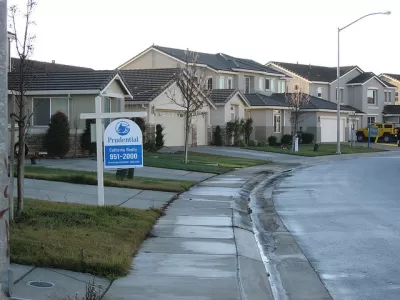The housing crisis that made headlines during the Great Recession is proving far more persistent than the common narrative about over-priced coastal market allows. A new report by the Center for American Progress uncovers the facts on the ground.

According to an article by Alana Semuels, "while the national housing market may be well on the way to recovery, the markets in some areas of the country are actually getting worse, according to a new report out from the Center for American Progress."
The key findings: some 7.5 million people owe more than their homes are worth. Semuels is careful to note the negative consequences of these underwater mortgages. "In some 1,000 counties, the number of underwater homes is stagnant or increasing, threatening already struggling regions with the potential of more foreclosures, more empty and abandoned homes, and more people who opt to rent instead of buy, which drives up the price of apartments."
Nationwide, about 15 percent of homeowners are underwater, which compares well to the 30 percent of homeowners underwater in 2011. But relative to the 4-5 percent of homeowners underwater in the late 1990s, the market currently resembles a crisis more than a recovery. Semuels notes that while the front lines of the foreclosure crisis concentrated in California, Florida, and Nevada, the report locates the problem in 2015 in "the South, upstate New York, and rural areas of Wisconsin…"
The article provides more details about conditions of the homeownership market in troubled counties, as well as more details about the consequences of underwater mortgages for individuals and communities. Also included are some of the report's recommendations for policies that could help stabilize the market.
FULL STORY: For Some Americans, the Housing Crisis Isn't Over

Planetizen Federal Action Tracker
A weekly monitor of how Trump’s orders and actions are impacting planners and planning in America.

Map: Where Senate Republicans Want to Sell Your Public Lands
For public land advocates, the Senate Republicans’ proposal to sell millions of acres of public land in the West is “the biggest fight of their careers.”

Restaurant Patios Were a Pandemic Win — Why Were They so Hard to Keep?
Social distancing requirements and changes in travel patterns prompted cities to pilot new uses for street and sidewalk space. Then it got complicated.

California Homeless Arrests, Citations Spike After Ruling
An investigation reveals that anti-homeless actions increased up to 500% after Grants Pass v. Johnson — even in cities claiming no policy change.

Albuquerque Route 66 Motels Become Affordable Housing
A $4 million city fund is incentivizing developers to breathe new life into derelict midcentury motels.

DC Area County Eliminates Bus Fares
Montgomery County joins a growing trend of making transit free.
Urban Design for Planners 1: Software Tools
This six-course series explores essential urban design concepts using open source software and equips planners with the tools they need to participate fully in the urban design process.
Planning for Universal Design
Learn the tools for implementing Universal Design in planning regulations.
Heyer Gruel & Associates PA
JM Goldson LLC
Custer County Colorado
City of Camden Redevelopment Agency
City of Astoria
Transportation Research & Education Center (TREC) at Portland State University
Camden Redevelopment Agency
City of Claremont
Municipality of Princeton (NJ)





























